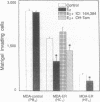Abstract
Breast cancers containing estrogen receptors are responsive to antiestrogen treatment and have a better prognosis than estrogen receptor-negative tumors. The loss of estrogen and progesterone receptors appears to be associated with a progression to less-differentiated tumors. We transfected the human estrogen receptor into the estrogen receptor-negative metastatic breast cancer cell line MDA-MB-231 in an attempt to restore their sensitivity to antiestrogens. Two stable sublines of MDA-MB-231 cells (HC1 and HE5) expressing functional estrogen receptors were studied for their ability to grow and invade in vitro and to metastasize in athymic nude mice. The number and size of lung metastases developed by these two sublines in ovariectomized nude mice was not markedly altered by tamoxifen but was inhibited 3-fold by estradiol. Estradiol also significantly inhibited in vitro cell proliferation of these sublines and their invasiveness in Matrigel, a reconstituted basement membrane, whereas the antiestrogens 4-hydroxytamoxifen and ICI 164,384 reversed these effects. These results show that estradiol inhibits the metastatic ability of estrogen receptor-negative breast cancer cells following transfection with the estrogen receptor, whereas estrogen receptor-positive breast cancers are stimulated by estrogen, indicating that factors other than the estrogen receptor are involved in progression toward hormone independence. Reactivation or transfer of the estrogen receptor gene can therefore be considered as therapeutic approaches to hormone-independent cancers.
Full text
PDF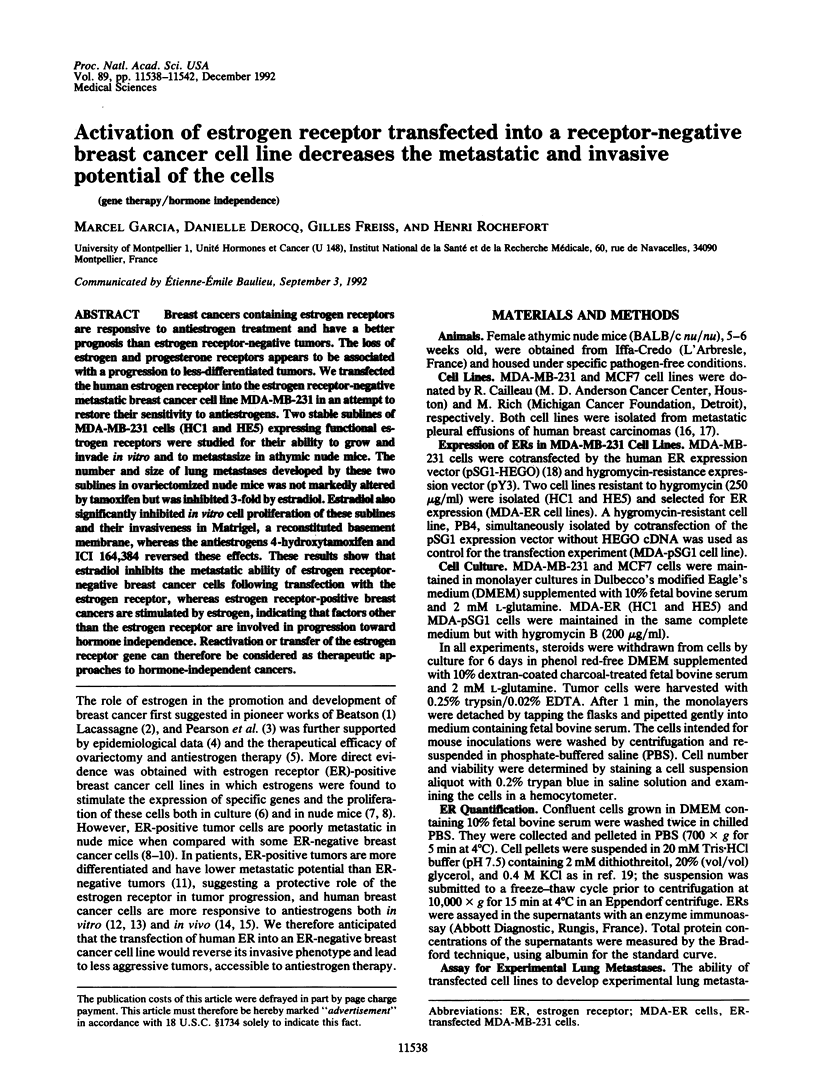
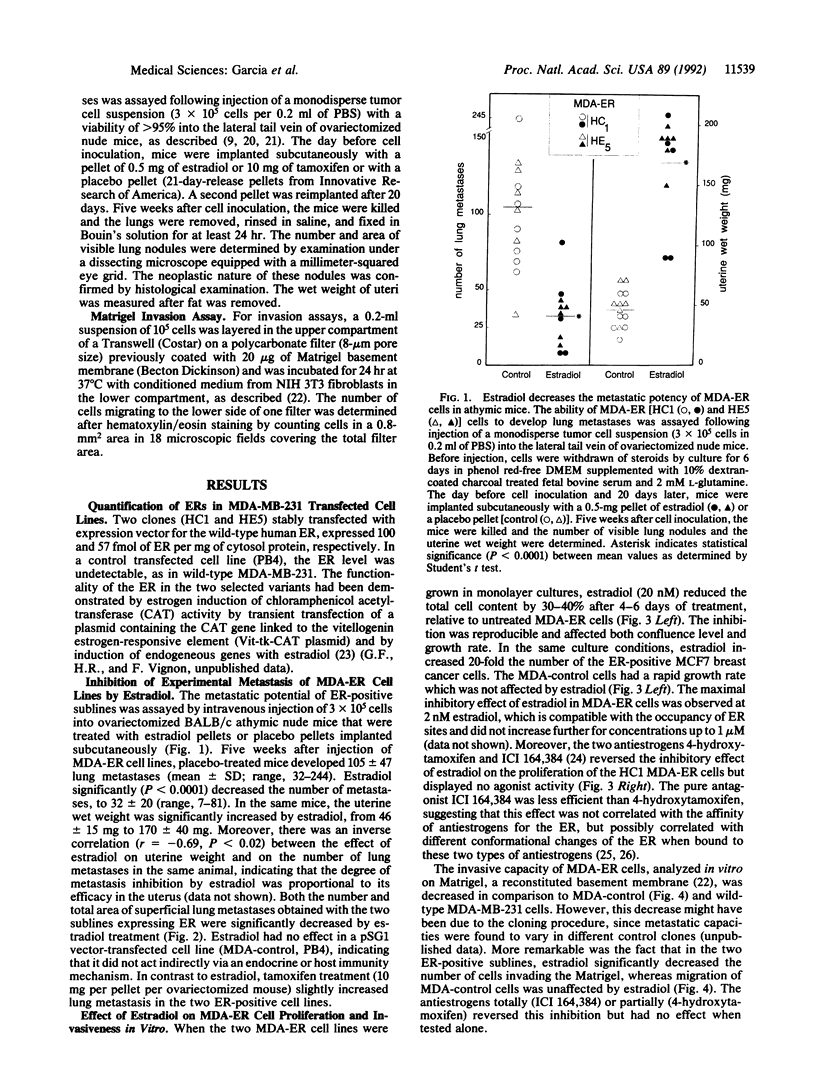
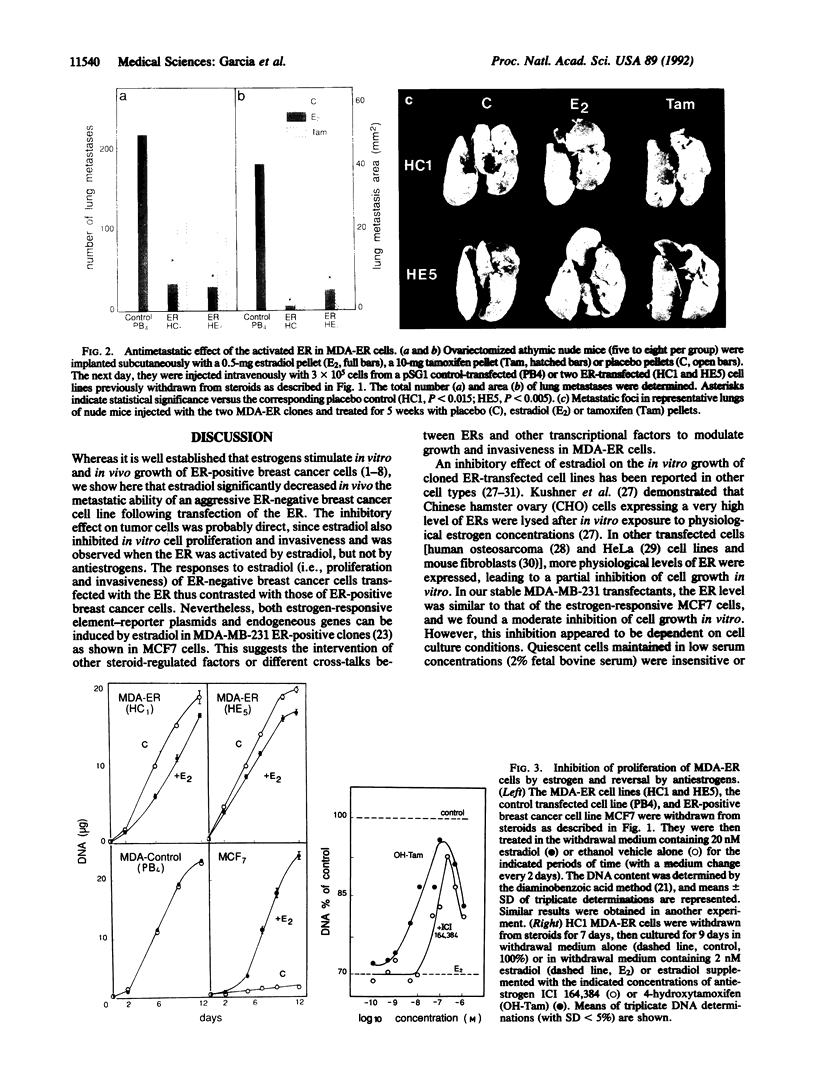
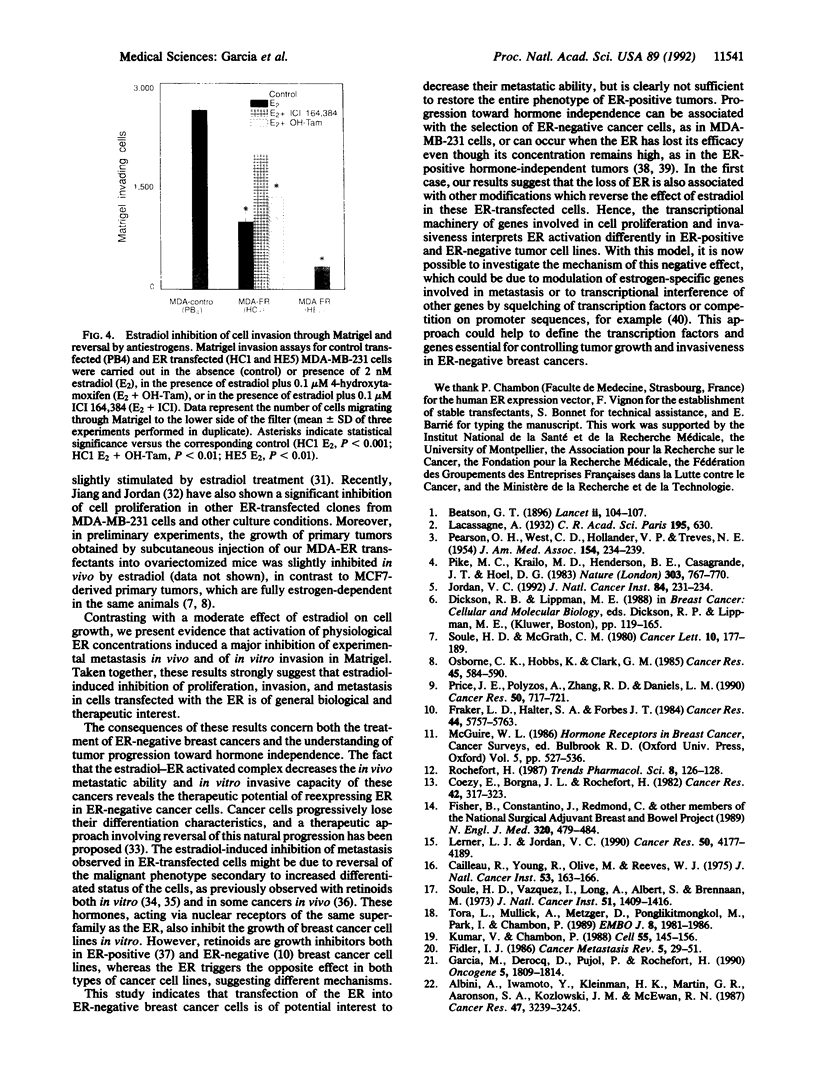
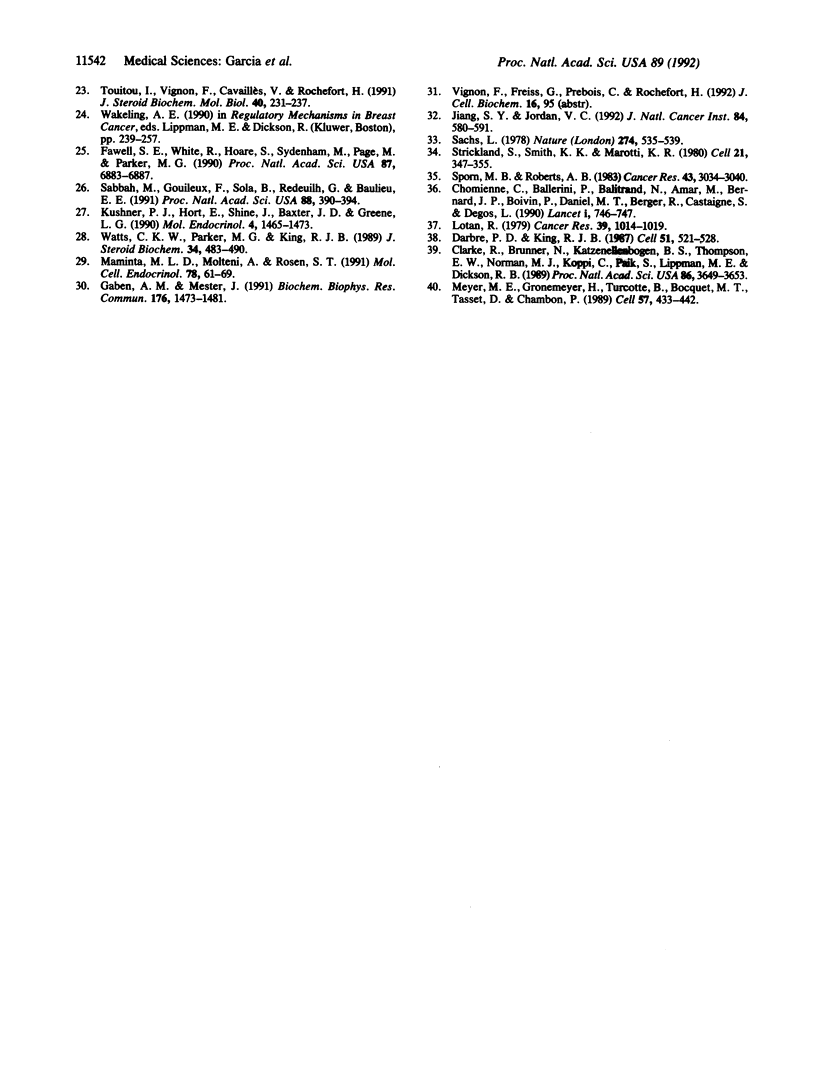
Images in this article
Selected References
These references are in PubMed. This may not be the complete list of references from this article.
- Albini A., Iwamoto Y., Kleinman H. K., Martin G. R., Aaronson S. A., Kozlowski J. M., McEwan R. N. A rapid in vitro assay for quantitating the invasive potential of tumor cells. Cancer Res. 1987 Jun 15;47(12):3239–3245. [PubMed] [Google Scholar]
- Clarke R., Brünner N., Katzenellenbogen B. S., Thompson E. W., Norman M. J., Koppi C., Paik S., Lippman M. E., Dickson R. B. Progression of human breast cancer cells from hormone-dependent to hormone-independent growth both in vitro and in vivo. Proc Natl Acad Sci U S A. 1989 May;86(10):3649–3653. doi: 10.1073/pnas.86.10.3649. [DOI] [PMC free article] [PubMed] [Google Scholar]
- Coezy E., Borgna J. L., Rochefort H. Tamoxifen and metabolites in MCF7 cells: correlation between binding to estrogen receptor and inhibition of cell growth. Cancer Res. 1982 Jan;42(1):317–323. [PubMed] [Google Scholar]
- Darbre P. D., King R. J. Progression to steroid insensitivity can occur irrespective of the presence of functional steroid receptors. Cell. 1987 Nov 20;51(4):521–528. doi: 10.1016/0092-8674(87)90121-8. [DOI] [PubMed] [Google Scholar]
- Fawell S. E., White R., Hoare S., Sydenham M., Page M., Parker M. G. Inhibition of estrogen receptor-DNA binding by the "pure" antiestrogen ICI 164,384 appears to be mediated by impaired receptor dimerization. Proc Natl Acad Sci U S A. 1990 Sep;87(17):6883–6887. doi: 10.1073/pnas.87.17.6883. [DOI] [PMC free article] [PubMed] [Google Scholar]
- Fidler I. J. Rationale and methods for the use of nude mice to study the biology and therapy of human cancer metastasis. Cancer Metastasis Rev. 1986;5(1):29–49. doi: 10.1007/BF00049529. [DOI] [PubMed] [Google Scholar]
- Fraker L. D., Halter S. A., Forbes J. T. Growth inhibition by retinol of a human breast carcinoma cell line in vitro and in athymic mice. Cancer Res. 1984 Dec;44(12 Pt 1):5757–5763. [PubMed] [Google Scholar]
- Gaben A. M., Mester J. BALB/C mouse 3T3 fibroblasts expressing human estrogen receptor: effect of estradiol on cell growth. Biochem Biophys Res Commun. 1991 May 15;176(3):1473–1481. doi: 10.1016/0006-291x(91)90453-e. [DOI] [PubMed] [Google Scholar]
- Garcia M., Derocq D., Pujol P., Rochefort H. Overexpression of transfected cathepsin D in transformed cells increases their malignant phenotype and metastatic potency. Oncogene. 1990 Dec;5(12):1809–1814. [PubMed] [Google Scholar]
- Jiang S. Y., Jordan V. C. Growth regulation of estrogen receptor-negative breast cancer cells transfected with complementary DNAs for estrogen receptor. J Natl Cancer Inst. 1992 Apr 15;84(8):580–591. doi: 10.1093/jnci/84.8.580. [DOI] [PubMed] [Google Scholar]
- Jordan V. C. Overview from the International Conference on Long-Term Tamoxifen Therapy for Breast Cancer. J Natl Cancer Inst. 1992 Feb 19;84(4):231–234. doi: 10.1093/jnci/84.4.231. [DOI] [PubMed] [Google Scholar]
- Kumar V., Chambon P. The estrogen receptor binds tightly to its responsive element as a ligand-induced homodimer. Cell. 1988 Oct 7;55(1):145–156. doi: 10.1016/0092-8674(88)90017-7. [DOI] [PubMed] [Google Scholar]
- Kushner P. J., Hort E., Shine J., Baxter J. D., Greene G. L. Construction of cell lines that express high levels of the human estrogen receptor and are killed by estrogens. Mol Endocrinol. 1990 Oct;4(10):1465–1473. doi: 10.1210/mend-4-10-1465. [DOI] [PubMed] [Google Scholar]
- Lerner L. J., Jordan V. C. Development of antiestrogens and their use in breast cancer: eighth Cain memorial award lecture. Cancer Res. 1990 Jul 15;50(14):4177–4189. [PubMed] [Google Scholar]
- Lotan R. Different susceptibilities of human melanoma and breast carcinoma cell lines to retinoic acid-induced growth inhibition. Cancer Res. 1979 Mar;39(3):1014–1019. [PubMed] [Google Scholar]
- Maminta M. L., Molteni A., Rosen S. T. Stable expression of the human estrogen receptor in HeLa cells by infection: effect of estrogen on cell proliferation and c-myc expression. Mol Cell Endocrinol. 1991 Jun;78(1-2):61–69. doi: 10.1016/0303-7207(91)90186-v. [DOI] [PubMed] [Google Scholar]
- Meyer M. E., Gronemeyer H., Turcotte B., Bocquel M. T., Tasset D., Chambon P. Steroid hormone receptors compete for factors that mediate their enhancer function. Cell. 1989 May 5;57(3):433–442. doi: 10.1016/0092-8674(89)90918-5. [DOI] [PubMed] [Google Scholar]
- Osborne C. K., Hobbs K., Clark G. M. Effect of estrogens and antiestrogens on growth of human breast cancer cells in athymic nude mice. Cancer Res. 1985 Feb;45(2):584–590. [PubMed] [Google Scholar]
- PEARSON O. H., WEST C. D., HOLLANDER V. P., TREVES N. E. Evaluation of endocrine therapy for advanced breast cancer. J Am Med Assoc. 1954 Jan 16;154(3):234–239. doi: 10.1001/jama.1954.02940370046013. [DOI] [PubMed] [Google Scholar]
- Pike M. C., Krailo M. D., Henderson B. E., Casagrande J. T., Hoel D. G. 'Hormonal' risk factors, 'breast tissue age' and the age-incidence of breast cancer. Nature. 1983 Jun 30;303(5920):767–770. doi: 10.1038/303767a0. [DOI] [PubMed] [Google Scholar]
- Price J. E., Polyzos A., Zhang R. D., Daniels L. M. Tumorigenicity and metastasis of human breast carcinoma cell lines in nude mice. Cancer Res. 1990 Feb 1;50(3):717–721. [PubMed] [Google Scholar]
- Sabbah M., Gouilleux F., Sola B., Redeuilh G., Baulieu E. E. Structural differences between the hormone and antihormone estrogen receptor complexes bound to the hormone response element. Proc Natl Acad Sci U S A. 1991 Jan 15;88(2):390–394. doi: 10.1073/pnas.88.2.390. [DOI] [PMC free article] [PubMed] [Google Scholar]
- Sachs L. Control of normal cell differentiation and the phenotypic reversion of malignancy in myeloid leukaemia. Nature. 1978 Aug 10;274(5671):535–539. doi: 10.1038/274535a0. [DOI] [PubMed] [Google Scholar]
- Soule H. D., McGrath C. M. Estrogen responsive proliferation of clonal human breast carcinoma cells in athymic mice. Cancer Lett. 1980 Aug;10(2):177–189. doi: 10.1016/0304-3835(80)90042-7. [DOI] [PubMed] [Google Scholar]
- Soule H. D., Vazguez J., Long A., Albert S., Brennan M. A human cell line from a pleural effusion derived from a breast carcinoma. J Natl Cancer Inst. 1973 Nov;51(5):1409–1416. doi: 10.1093/jnci/51.5.1409. [DOI] [PubMed] [Google Scholar]
- Sporn M. B., Roberts A. B. Role of retinoids in differentiation and carcinogenesis. Cancer Res. 1983 Jul;43(7):3034–3040. [PubMed] [Google Scholar]
- Strickland S., Smith K. K., Marotti K. R. Hormonal induction of differentiation in teratocarcinoma stem cells: generation of parietal endoderm by retinoic acid and dibutyryl cAMP. Cell. 1980 Sep;21(2):347–355. doi: 10.1016/0092-8674(80)90471-7. [DOI] [PubMed] [Google Scholar]
- Tora L., Mullick A., Metzger D., Ponglikitmongkol M., Park I., Chambon P. The cloned human oestrogen receptor contains a mutation which alters its hormone binding properties. EMBO J. 1989 Jul;8(7):1981–1986. doi: 10.1002/j.1460-2075.1989.tb03604.x. [DOI] [PMC free article] [PubMed] [Google Scholar]
- Touitou I., Vignon F., Cavailles V., Rochefort H. Hormonal regulation of cathepsin D following transfection of the estrogen or progesterone receptor into three sex steroid hormone resistant cancer cell lines. J Steroid Biochem Mol Biol. 1991;40(1-3):231–237. doi: 10.1016/0960-0760(91)90187-a. [DOI] [PubMed] [Google Scholar]
- Watts C. K., Parker M. G., King R. J. Stable transfection of the oestrogen receptor gene into a human osteosarcoma cell line. J Steroid Biochem. 1989;34(1-6):483–490. doi: 10.1016/0022-4731(89)90132-5. [DOI] [PubMed] [Google Scholar]




